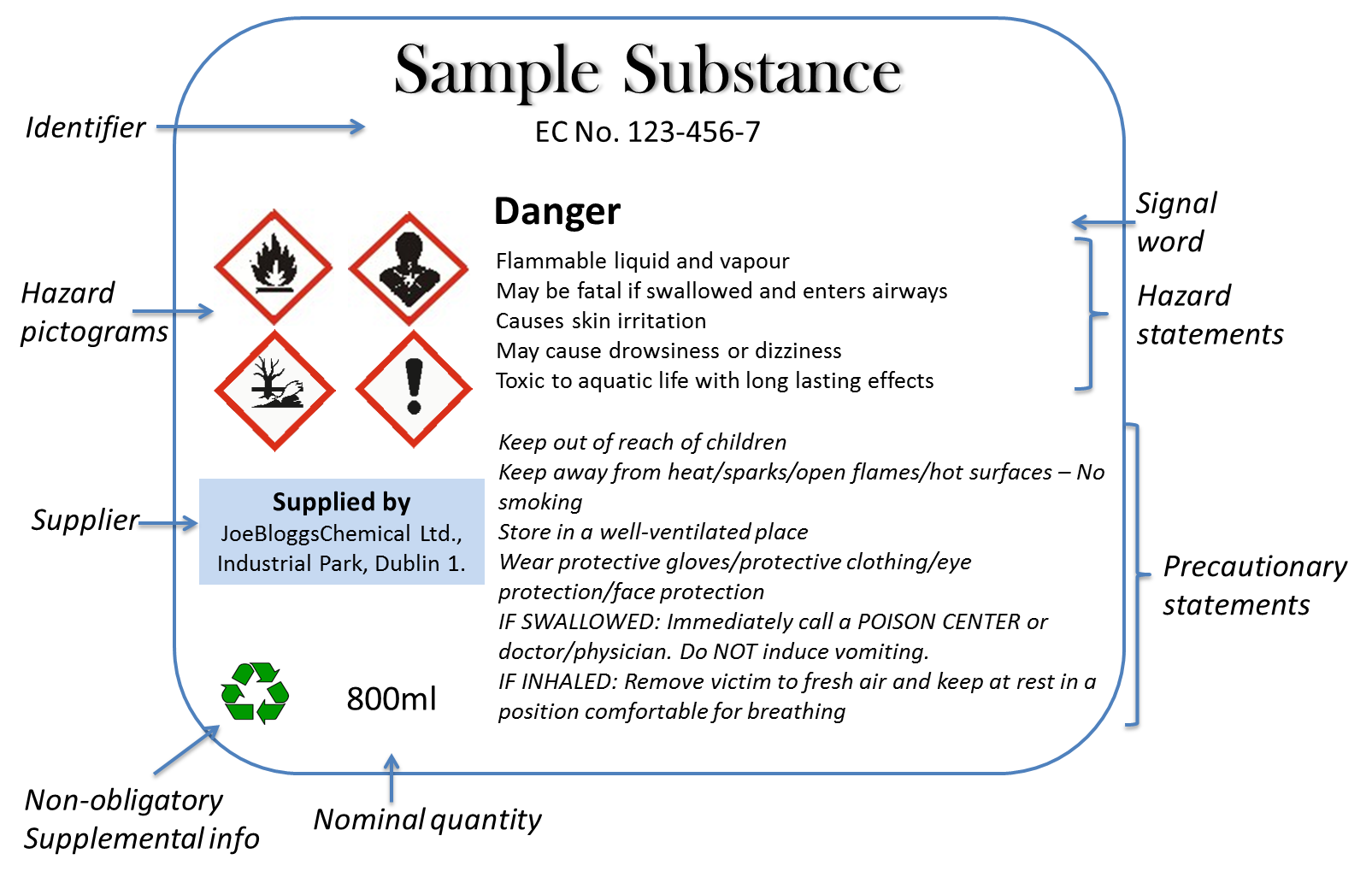 Hazard Communication
Hazard Communication
The hazard label is the main communication tool for the classification of hazardous substances and mixtures. Together with the safety data sheet, the hazard label should be consistent in communicating any hazard information for a given substance or mixture to the user. This enables the user to best protect himself during use. The responsibility for labelling lies with the manufacturer of a substance, an importer of a substance or a mixture and/or downstream user i.e. a formulator of a mixture who supplies, or makes available, hazardous substances and/or mixtures to a third party, whether professional or consumer, within the European Union (EU). Where a hazardous substance or mixture is being sold online, there is also a requirement to communicate the hazard(s) of that substance or mixture in the advertisement.
Labelling
A substance or mixture contained in packaging should be labelled according to CLP before placing it on the market where it is classified as hazardous. A manufacturer, importer, downstream user (including formulator) or distributor (including retailer) must label any substance or mixture before placing it on the market. Distributors need not classify from scratch, but use the classification from their supplier, provided classification is derived using CLP. This also applies to downstream users, provided the composition of the substance or mixture is not changed.
Elements of a Hazard Label
A hazard label must contain the following:
- name, address and telephone number of the EU supplier
- product identifiers e.g. chemical name and CAS/EC no. for a substance/trade name of a mixture as well as chemical name(s) of all substances responsible for classification of mixture (excluding skin and eye irritants)
- relevant hazard pictogram(s)
- relevant signal word: either Warning or Danger dependent on classification
- hazard statement(s) description of the hazardous effect e.g. Harmful if inhaled
- appropriate precautionary statements to allow the user to take measures to protect health/environment e.g. Keep out of reach of children,
- nominal quantity (for supply to general public)
- obligatory supplemental information which comprise of hazard statements taken over from previous chemical legislation e.g. EUH001 Explosive when dry and EUH204 Contains isocyanates. May produce an allergic reaction”
Non-obligatory supplemental labelling information is not part of the legal labelling requirements under CLP, for example, instructions for use. Such information must not distract from nor contradict the obligatory label elements and statements, for example ‘non-toxic’ or ‘non-polluting’ must not be used.
Layout of the Hazard Label
The label must:
- be firmly attached to the surface of the product
- be visible and readable in English
- have all hazard pictograms, signal word, hazard and precautionary statements together
- have all hazard and precautionary statements of the same language grouped together where there is more than one language is used
- ensure that the hazard pictogram stands out clearly (black print on white background surrounded by red frame being at least one fifteenth and at least 1 cm2 of the label)
- have the following dimensions (special exemptions from the labelling obligation apply for small packages containing up to and not more than 125 ml):
Minimum dimensions of labels and pictograms| Capacity of the package | Dimensions of label (mm) for Article 17 information | Dimension of each pictogram (mm) |
|---|
| ≤ 3 litres | If possible at least 52 x 74 | Not smaller than 10 x 10. If possible 16 x 16 |
| > 3 litres but ≤ 50 litres | At least 74 x 105 | At least 23 x 23 |
| > 50 litres but ≤ 500 litres | At least 105 x 148 | At least 32 x 32 |
| > 500 litres | At least 148 x 210 | At least 46 x 46 |
Example of a Hazard Label

Labels for Supply and Transport
For hazardous substances and mixtures that are transported by road, every inner and intermediate layer of packaging must be labelled according to CLP and outer packaging must be labelled according to ADR. Outer packaging may also carry CLP labelling, however this is not a requirement unless hazardous substances are provided in a single package (e.g. a drum). Single packages must carry both the CLP and the ADR label elements. ADR labels or marks take precedence over CLP pictograms on a combined supply and transport label for the same hazard. Please consult the ADR section of our website.
Derogations from Labelling
Derogations for labelling are permitted where packages are of such a shape or so small so to not allow the necessary hazard labelling information fit on the label. In such cases and where applicable, the label elements may be provided either on:
- fold-out labels; or on
- tie-on tags; or on
- outer packaging
A derogation also applies for chemicals for supply for R&D or Quality Control analysis where the contents of the inner package do not exceed 10ml and where the outer package is labelled accordingly. Derogations from hazard labelling requirements are also permitted in special cases including transportable gas cylinders, gas containers intended for propane, butane or liquefied petroleum gas, certain aerosols, certain mixtures containing elastomers and explosives as well as in the case of soluble packaging.
Substances or mixtures that are not placed on the market, such as decanted chemicals, do not come under the scope of the CLP Regulation. It is important however, that a risk-based approach to potential hazards and the requirement to label ‘in-house’ containers are considered under the remit of the Chemical Agent Regulations and the Work Place Signs Regulations. Further information is available in our publication Your Steps to Chemical Safety
Labelling Guidance:
HSA: Hazard, Labelling & Packaging according to the CLP Regulation
ECHA: Guidance on Labelling and Packaging
ECHA: Specific Labelling and Packaging Situations
ECHA: List of EU language requirements for labelling
Safety Data Sheets
(Re-direct)

Return to Classification & Labelling Home